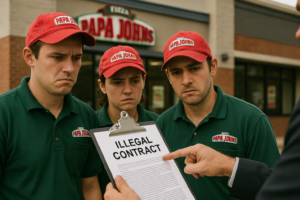
Papa John’s “No-Poach” Employee Mobility Case
In a long-running case dating to 2018, employees alleged that Papa John’s franchise agreements included “no-poach” or non-solicitation clauses among franchisees, which suppressed workers’ mobility


In a long-running case dating to 2018, employees alleged that Papa John’s franchise agreements included “no-poach” or non-solicitation clauses among franchisees, which suppressed workers’ mobility

In Ana Cantu v. Google, LLC, a proposed class action alleges that Google favored White and Asian employees in pay and promotion decisions, discriminating against Hispanic,
Employment class action lawsuits serve as one of the most powerful instruments for advancing fair labor practices in the United States. They address systemic violations of wage, hour, discrimination, and benefit laws that harm groups of employees across industries. By aggregating numerous small or moderate claims into a single, coordinated proceeding, class actions level the playing field between individual workers and large corporate employers.
In doing so, employment class actions not only compensate affected workers but also foster corporate compliance, reinforce statutory labor protections, and ultimately promote economic equity. Their significance extends well beyond the courtroom—these cases influence business conduct, deter exploitation, and ensure that labor markets remain both lawful and competitive.
Employment class actions typically arise under federal statutes such as:
The Fair Labor Standards Act (FLSA) – governing minimum wage, overtime pay, and record-keeping.
Title VII of the Civil Rights Act of 1964 – prohibiting employment discrimination on the basis of race, color, religion, sex, or national origin.
The Age Discrimination in Employment Act (ADEA) and Americans with Disabilities Act (ADA) – protecting against age- and disability-based discrimination.
The Employee Retirement Income Security Act (ERISA) – addressing pension and benefits mismanagement.
In addition to federal law, nearly every state has its own wage, hour, and fair employment statutes, often providing broader or more employee-friendly protections.
While many employment cases proceed as Rule 23(b)(3) class actions, wage-and-hour claims under the FLSA often utilize the “collective action” mechanism, requiring similarly situated employees to affirmatively opt in. Both procedures aim to resolve common legal and factual questions efficiently, ensuring uniform relief and avoiding inconsistent rulings.
Key prerequisites include establishing commonality, typicality, and adequacy of representation, meaning the employees’ claims must arise from a common policy or practice, and the class representative must fairly advocate for all members.
Employment class actions seek a range of remedies, including:
Back pay and unpaid overtime
Liquidated or statutory damages
Restitution of misclassified wages or benefits
Injunctive relief requiring policy reforms or anti-discrimination training
Attorneys’ fees and costs
Beyond monetary relief, these cases often lead to significant institutional reforms—rewritten policies, reclassification of workers, or the establishment of compliance monitoring—all of which create lasting societal benefits.
Perhaps the most famous employment class action in modern history, Dukes v. Wal-Mart involved claims that the retail giant systematically discriminated against female employees in pay and promotions. Although the U.S. Supreme Court ultimately decertified the nationwide class on procedural grounds, the case transformed employment litigation.
The decision clarified the limits of class certification under Rule 23, particularly regarding the need for common proof of discrimination. While the plaintiffs did not prevail, the case catalyzed extensive internal diversity initiatives within Wal-Mart and other corporations, leading to greater transparency and gender equity programs across the retail sector.
Employees at Tyson Foods alleged that the company failed to compensate them for time spent donning and doffing required protective gear—a common issue in manufacturing and food-processing industries. The case culminated in a U.S. Supreme Court decision affirming that statistical sampling could be used to establish class-wide liability where uniform policies led to common harm.
The final settlement exceeded $32 million and compelled Tyson Foods to reform timekeeping procedures company-wide. The case reinforced that collective action is essential for vindicating small, systemic wage claims that would otherwise be economically infeasible to pursue individually.
Ride-share companies Uber and Lyft faced multiple class actions alleging that they misclassified drivers as independent contractors rather than employees—denying them overtime pay, reimbursement, and benefits.
Although early settlements were modest, later agreements—such as Uber’s $100 million settlement in 2022—represented a major acknowledgment of the changing dynamics of the “gig economy.” These cases advanced national debate on worker classification, ultimately leading several states, including California, to enact legislation defining employee status more rigorously.
In one of the largest independent contractor cases in U.S. history, thousands of FedEx Ground drivers alleged they were improperly classified as contractors despite being subject to strict company control. The consolidated litigation led to hundreds of millions in settlements across multiple states.
The case demonstrated how large corporations can use uniform contractor models to circumvent employment laws—and how coordinated litigation can compel structural reform across entire industries.
Female employees of Sterling Jewelers, the parent company of Jared and Kay Jewelers, brought claims alleging widespread gender discrimination in pay and promotions. The class-wide arbitration that followed resulted in more than $175 million in settlements and substantial injunctive relief, including the establishment of fair pay audits and anti-discrimination monitoring.
This case underscored the continuing importance of gender equity enforcement, particularly in large service-sector employers where subjective promotion criteria can conceal systemic bias.
In recent years, Amazon has faced class actions alleging failure to pay for time spent undergoing mandatory security screenings before and after shifts. While litigation outcomes have varied across jurisdictions, several state settlements provided millions in back pay and helped push major retailers to revise warehouse timekeeping and break policies, improving conditions for hourly workers nationwide.
Employment class actions restore fairness to labor markets by ensuring that workers receive the compensation and treatment they are legally owed. Recoveries for unpaid wages, overtime, and benefits redistribute earnings more equitably, promoting economic justice across socioeconomic strata.
The financial and reputational consequences of large settlements encourage employers to invest in compliance programs and ethical management practices. Knowing that patterns of misconduct can lead to multi-million-dollar liability discourages exploitation and underpayment.
Many settlements include injunctive terms that require employers to update handbooks, improve diversity and inclusion programs, or implement neutral promotion criteria. These reforms extend benefits far beyond the named plaintiffs, improving workplace culture across entire organizations.
By aggregating similar claims, class actions prevent hundreds or thousands of duplicative lawsuits, conserving judicial resources and ensuring uniform adjudication. This efficiency strengthens the rule of law and enhances predictability for both employees and employers.
At their core, employment class actions reaffirm the principle that economic power must be balanced by accountability. They give voice to employees who might otherwise remain silent, reinforcing public faith that the legal system can protect workers even against the most powerful corporations.
Employment class action lawsuits occupy a critical space in American jurisprudence. They vindicate statutory rights, redress widespread injustice, and compel systemic change in corporate governance. From factory floors to digital platforms, these cases have shaped the contours of the modern workplace by demanding compliance, transparency, and respect for labor law.
As technology reshapes employment and the gig economy blurs the line between worker and contractor, the class action mechanism remains indispensable. It ensures that the fundamental promise of fairness at work—equal pay for equal effort, dignity, and lawful treatment—remains a lived reality rather than an abstract ideal.
We are a leading online resource for consumers seeking clear, trustworthy information about ongoing and emerging class action lawsuits across the United States. Designed to empower individuals with knowledge and access, the site connects users directly with experienced class action law firms who can evaluate potential claims and represent them in pursuing justice through collective litigation. From product defects and data breaches to employment and securities fraud, ClassActionFirms.com provides up-to-date summaries of major cases, explains how class actions work, and helps consumers find qualified legal counsel to protect their rights and hold corporations accountable.